NVIDIA’s GeForce GTX Titan Review, Part 2: Titan's Performance Unveiled
by Ryan Smith & Rahul Garg on February 21, 2013 9:00 AM ESTCrysis: Warhead
Up next is our legacy title for 2013, Crysis: Warhead. The stand-alone expansion to 2007’s Crysis, at over 4 years old Crysis: Warhead can still beat most systems down. Crysis was intended to be future-looking as far as performance and visual quality goes, and it has clearly achieved that. We’ve only finally reached the point where single-GPU cards have come out that can hit 60fps at 1920 with 4xAA.
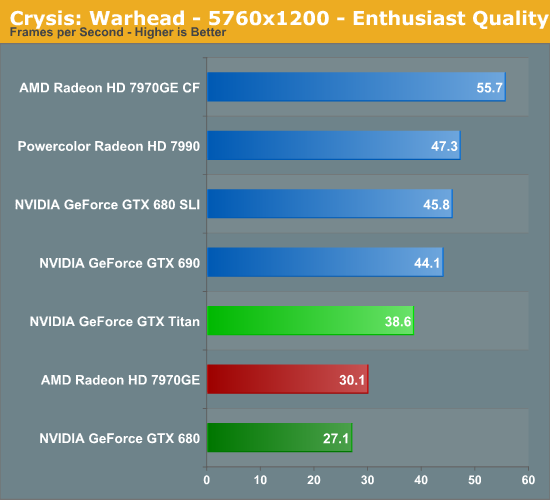

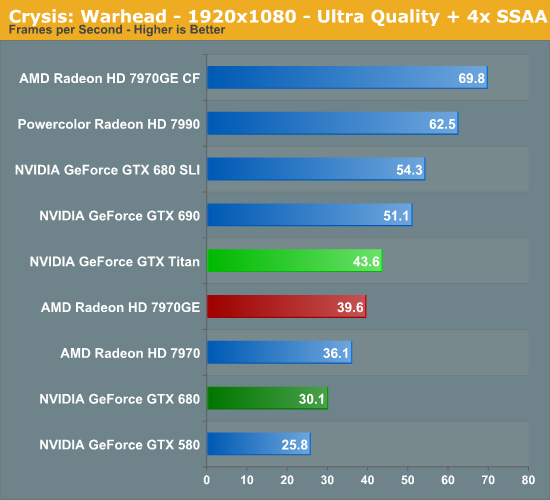

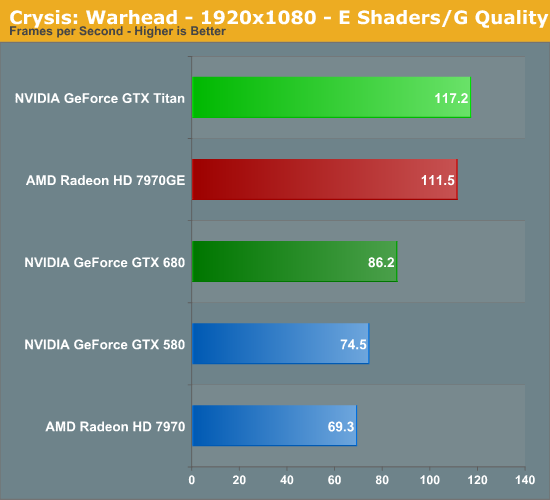
At 2560 we still have a bit of a distance to go before any single-GPU card can crack 60fps. In lieu of that Titan is the winner as expected. Leading the GTX 680 by 54%, this is Titan’s single biggest win over its predecessor, actually exceeding the theoretical performance advantage based on the increase in functional units alone. For some reason GTX 680 never did gain much in the way of performance here versus the GTX 580, and while it’s hard to argue that Titan has reversed that, it has at least corrected some of the problem in order to push more than 50% out.
In the meantime, with GTX 680’s languid performance, this has been a game the latest Radeon cards have regularly cleared. For whatever reason they’re a good match for Crysis, meaning even with all its brawn, Titan can only clear the 7970GE by 21%.
On the other hand, our multi-GPU cards are a mixed bag. Once more Titan loses to both, but the GTX 690 only leads by 15% thanks to GK104’s aforementioned weak Crysis performance. Meanwhile the 7990 takes a larger lead at 33%.
I’d also note that we’ve thrown in a “bonus round” here just to see when Crysis will be playable at 1080p with its highest settings and with 4x SSAA for that picture-perfect experience. As it stands AMD multi-GPU cards can already cross 60fps, but for everything else we’re probably a generation off yet before Crysis is completely and utterly conquered.
Moving on, we once again have minimum framerates for Crysis.
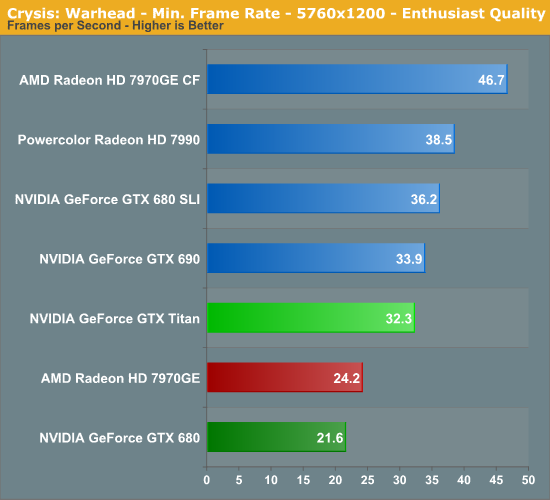
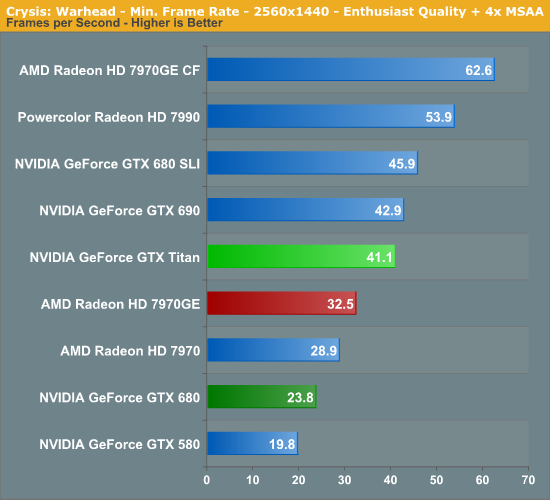
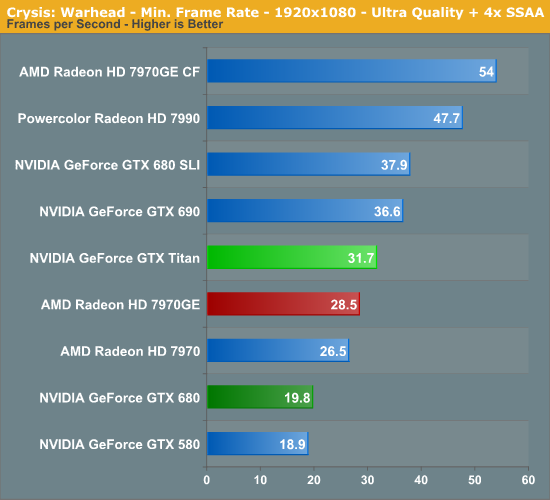
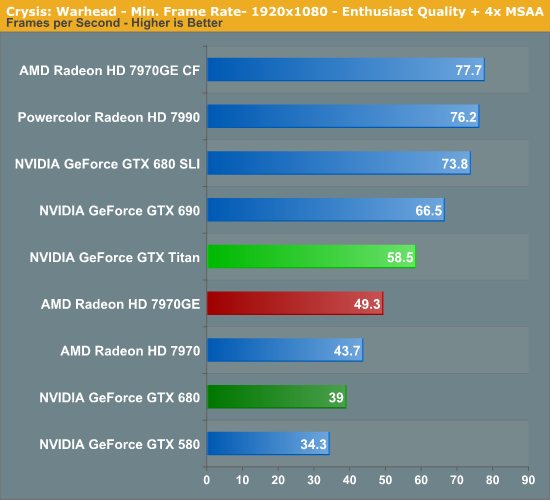
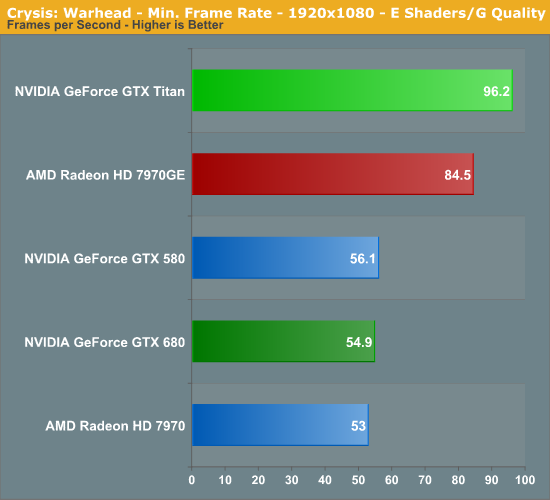
When it comes to Titan, the relative improvement in minimum framerates over GTX 680 is nothing short of obscene. Whatever it was that was holding back GTX 680 is clearly having a hard time slowing down Titan, leading to Titan offering 71% better minimum framerates. There’s clearly much more going on here than just an increase in function units.
Meanwhile, though Titan’s gains here over the 7970GE aren’t quite as high as they were with the GTX 680, the lead over the 7970GE still grows a bit to 26%. As for our mutli-GPU cards, this appears to be a case where SLI is struggling; the GTX 690 is barely faster than Titan here. Though at 31% faster than Titan, the 7990 doesn’t seem to be faltering much.










337 Comments
View All Comments
CeriseCogburn - Saturday, February 23, 2013 - link
You seem to keep forgetting nearly all other computer parts, since our illustrious communist has usurped the perch, have also not fallen in price, as has traditionally been the case.Computers parts across the board are staying the same and rising in price.
It's called a crappy world money printing inflationary mess.
If you haven't noticed it, you're clueless.
chizow - Saturday, February 23, 2013 - link
Yeah once again you must be living in a parallel universe.PCs, and electronics in general, are all getting cheaper in price and increasing in performance with each iteration. Hell even Apple products have lower price points than they did 3-4 years ago across the board.
Just look at laptops for example. You can get a solid "Ultrabook" laptop for $500-800. Same class of laptop would've cost you $1200-$1500 5 years ago.
CeriseCogburn - Tuesday, February 26, 2013 - link
A finished product is not a computer part you fool.Nice try liar.
colonelpepper - Thursday, February 21, 2013 - link
VueAvid
Maya
Autocad
3DS Max
After Effects
Adobe Creative Suite
This card is touching the boundary between gaming & QUADRO cards and yet there are ZERO benchmarks for any of this software yet page after page after page after page dedicated to various games.
What gives?
Perhaps Toms will have a relevant review.
Hrel - Thursday, February 21, 2013 - link
I was wondering about this as well. Dustin even says it designed as a "cheap compute card".I'd add PowerDirector to the list though.
Hrel - Thursday, February 21, 2013 - link
Ryan*JarredWalton - Thursday, February 21, 2013 - link
Keep in mind the time constraints. Ryan and Anand received the Titan hardware late last week; adding in additional testing for this article is a bit much, considering Ryan already had to write the initial Part 1 plus this Part 2. I'm guessing that performance in professional apps where Quadro is usually the go-to choice aren't going to benefit all that much from Titan relative to GTX 680, though, unless NVIDIA is reversing their stance on Quadro getting special drivers (which doesn't seem to be the case).dbr1 - Thursday, February 21, 2013 - link
Exactly!How does this card perform in Adobe Premiere Pro???
atlr - Thursday, February 21, 2013 - link
Seeing performance of a benchmark like http://ppbm5.com/ with Creative Suite v6.03 across the set of Nvidia and AMD cards would be interesting. I have not found runs of this benchmark with a AMD 7970 yet. CUDA rules the Adobe roost although there is some OpenCL support in current products.Ryan Smith - Monday, February 25, 2013 - link
Due to the disparity in GeForce and Quadro drivers, not to mention the difference in support, these are programs where for the most part it wouldn't make much sense to benchmark them on a GeForce Titan. Now if NVIDIA rolls out a GK110 Quadro, then that would be far more useful.If you're in the market for a Quadro, you're probably not in the market for a GeForce. NVIDIA keeps those market segments rather rigorously separated.